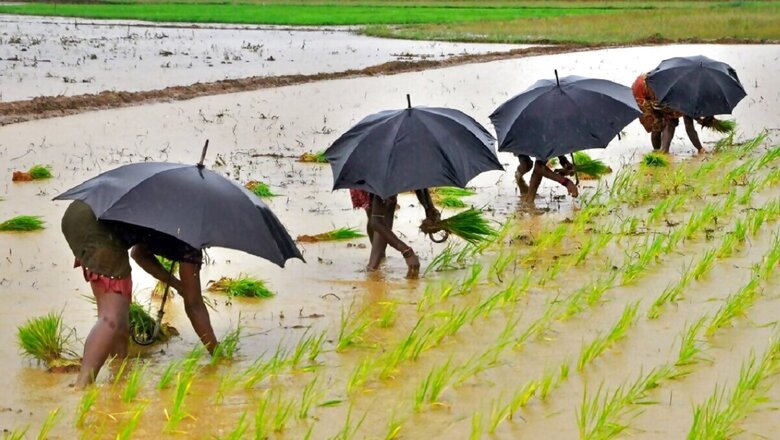
views
The Green Revolution in India has been regarded as a pivotal chapter in the country’s agricultural history. By sharply raising agricultural output and aiding India in making the transition from a food-deficient to a predominantly self-sufficient country, it represented a momentous watershed point. India was highly dependent on food imports, especially wheat, to fulfil its escalating food demands prior to the Green Revolution period.
In this week’s Classes With News18, let us trace the timeline of the Green Revolution in India, highlighting key developments and their impact on the nation’s agricultural landscape.
The genesis of the Green Revolution may be attributed back to a time when agricultural production in India faced a variety of challenges. Adequate crop production, be it wheat, rice or any other pulses was a pressing concern at the time given. On the one hand, traditional agricultural methods, crop types with low yields, inadequate irrigation, and a high dependence on food imports from foreign nations were prevalent in India. On the other hand, the population was growing quickly and the availability of food could not keep up with the demand. India’s Green Revolution resulted in higher agricultural production, particularly in the nation’s major agricultural-producing states—Haryana, Punjab, and Uttar Pradesh.
Introduction of High-Yielding Varieties
Dr. Norman Borlaug, an American agronomist who developed high-yielding wheat varieties in Mexico, was the forerunner of this revolution. These wheat strains, known as “miracle wheat,” encouraged Indian scientists to use this technique since it had the potential to dramatically increase agricultural yields. The introduction of high-yielding varieties (HYVs) of wheat and rice marked the formal start of India’s Green Revolution in the mid-1960s.
Dr. M.S. Swaminathan was a pioneer in promoting the use of HYVs for wheat production in India and is referred to as the “Father of the Green Revolution in India”. These HYVs revolutionised Indian agriculture by guaranteeing noticeably increased crop yields.
Adoption of HYVs and Technological and Irrigation Expansions
In India, HYVs were widely used in the 1960s and 1970s, especially in northern states. These new crop types started to pay off for farmers since they produced more grain per acre. The government had put out initiatives to provide farmers access to loans, farm equipment, and extension services in order to facilitate this change. In addition to putting in place price support measures, the government bought farmers’ excess grain at minimum support rates. Furthermore, it developed agricultural research institutions and colleges to further develop crop technology and enhance farming practices.
The development of irrigation infrastructure was a vital aspect of the Green Revolution. To supply water to the HYV crops, massive irrigation projects like the Indira Gandhi Canal and the Bhakra-Nangal Dam were undertaken by the government of India. This strengthened farming’s resilience by stabilising agricultural output and lowering dependence on monsoon rains for irrigation of the crops. Notably, India reduced its dependency on food imports by becoming self-sufficient in the production of rice and wheat by the late 1970s resolved its food security concerns and brought down famine-related problems.
Expansion Beyond Wheat and Rice
The Green Revolution grew to encompass maize, millets, and pulses in addition to wheat and rice in the 1980s and 1990s. This diversification aided in boosting the variety of food produced, lowering the agricultural sector’s susceptibility to crop failures, and encouraging a healthy diet. Due to a more than three-fold rise in wheat production between 1967–1968 and 2003–2004, the Green Revolution in India may also be referred to as the Wheat Revolution.
In the 1990s, a “Second Green Revolution” with an emphasis on more agricultural technology breakthroughs arose. Genetically modified (GM) crops, such as Bt cotton, were developed during this time and helped boost cotton yields while lowering losses from parasites.
There’s no denying the Green Revolution’s influence on Indian agriculture. However, issues including decreasing soil fertility, a lack of water, and the negative consequences of climate change still exist. Farmers are responding to these problems while also attempting to secure food security for a continually expanding populace. Promoting agroecological methods and lessening agriculture’s environmental impact are becoming more and more important goals.
To learn about other topics taught in school, explained by News18, here is a list of other Classes With News18: Queries Related to Chapters on Elections | Sex Versus Gender | Cryptocurrencies | Economy & Banks | How to Become President of India | Post Independence Struggle | How India Adopted Its Flag | Formation of States & United India | Tipu Sultan | Indian Teachers Day Different from Rest of the World |Queen Elizabeth & Colonialism | Article 370 | India’s Manufacturing Industries|
















Comments
0 comment